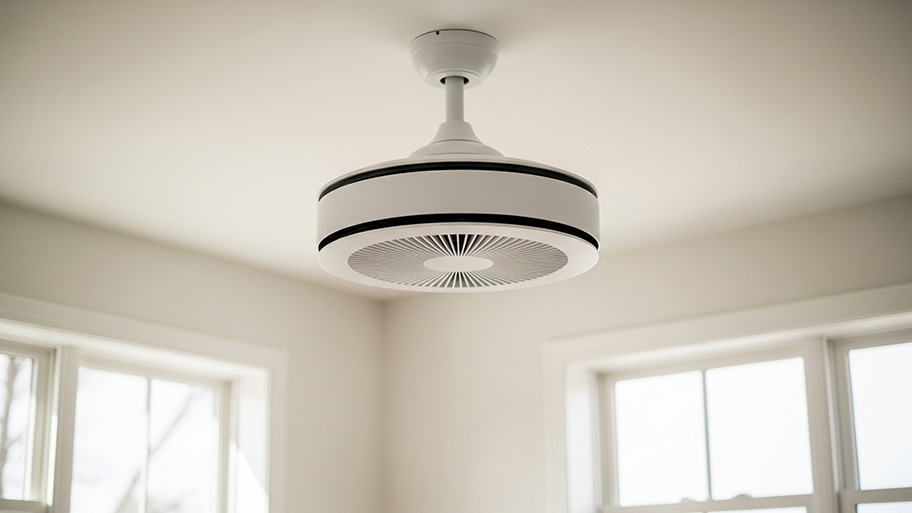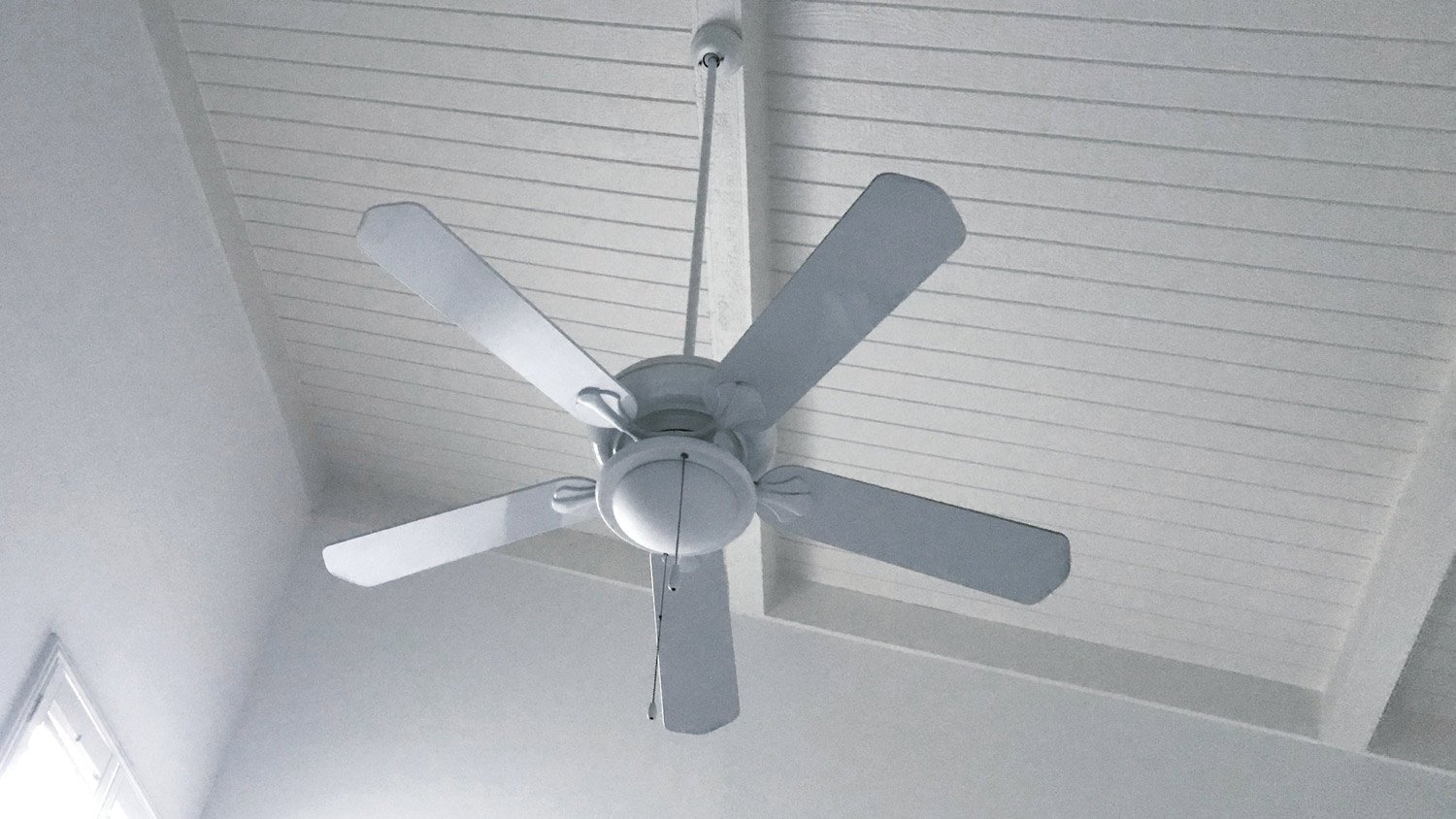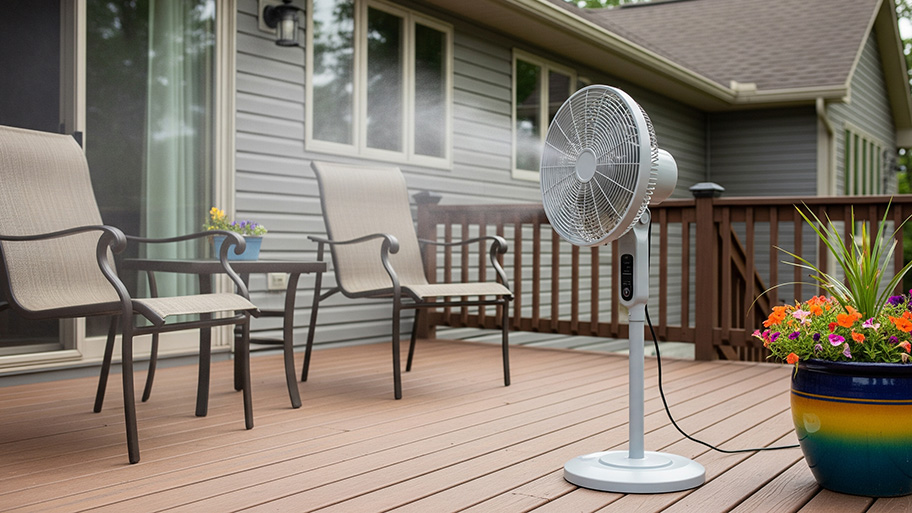
If your ceiling fan stops working due to a bad motor or broken pull chain, here’s what you can expect to pay to get it fixed.
Find the right fit for your fan


Ceiling fan position, ceiling height, and ceiling fan airflow affect the ideal size of your ceiling fan.
Ceiling fans work best when installed eight to nine feet above the floor.
Medium-sized rooms (100–400 square feet in diameter) require 29- to 39-inch ceiling fans.
Living rooms, primary bedrooms, and large bathrooms are rooms that require the largest size ceiling fans.
Ceiling fans are great additions to indoor and outdoor spaces, especially when you want an energy-efficient way to cool down a room and enjoy a light breeze. Use our ceiling fan size guide to determine the right size fan for your space to get optimal cooling and air circulation. Follow along to learn how to find the right fixture for your room with the help of a ceiling fan installation professional.
Ceiling fan sizes are based on the diameter of the room. Larger rooms get larger fans to move larger quantities of air around. So, let's divide standard ceiling fan blade sizes into three distinct categories:
| Room Size | Room Diameter in Square Feet | Ceiling Fan Size in Inches |
|---|---|---|
| Small room | Under 100 | 29–39 |
| Medium room | 100–400 | 42–52 |
| Large | More than 400 | 56–71 |
The ideal fan should provide optimal circulation for your space without overwhelming it. A ceiling fan that’s too small won't adequately cool your room and will have to work twice as hard to circulate air, which can reduce the fan’s life span. An oversized fan can physically and visually overwhelm your space, create excessive noise, and provide sub-optimal energy efficiency.
Ceiling fan sizes are rarely determined by style or materials, even though ceiling fan types vary from farmhouse to industrial and handcrafted wood to metal blades. Instead, you can estimate the size of your ceiling fan based on the type of room in which you want to install. Let’s look at a few specific room examples for more sizing recommendations.
| Room Type | Fan Size in Inches |
|---|---|
| Bathroom | 26–29 |
| Bedroom | 52–56 |
| Outdoor space | 36–54 |
| Living room | 60+ |
A home office or extra bedroom is one of the smallest rooms in a house at 70 to 150 square feet. A small ceiling fan, 29 inches at most, works best in these rooms. A fan in a home office may be particularly important because of the heat a computer station can produce.
Bathrooms are small spaces, but it’s important that fans move air quickly to help dehumidify the space. If your bathroom includes a ceiling fan, it should be 29 to 26 inches, depending on the room’s square footage and ceiling height.
If you have a large bathroom connected to your primary bedroom, don’t be afraid to go bigger with your ceiling fan. Adding a fan that’s 52 to 56 inches can help dry a bathroom and circulate air more quickly.
Laundry rooms tend to be smaller, but circulating extra heat or steam can be more important in this type of space based on its function. A fan between 29 and 36 inches should work well, but larger laundry rooms can consult a ceiling fan installer about upgrading to a larger size.
If you have a separate entryway space, consider a small ceiling fan to help manage the temperature at a comfortable level. A 29 to 36-inch fan is appropriate, but if your entryway and living or sitting room merge together, you don’t need a fan in each area.
Ceiling fans are important tools that keep primary bedrooms cool in summer and warmer when the temperature drops. Choose a fan between 52 and 56 inches for large primary bedrooms or consider an even larger size if the room’s square footage exceeds 400 square feet.
Living rooms tend to be one of the largest rooms in the house and experience frequent activity. A fan larger than 60 inches is appropriate for most living room spaces, although you can downsize for smaller living rooms.
Outdoor fans help keep important spots comfortable when the summer weather starts heating up, like gazebos or other features with access to outdoor air. These fans encounter more moisture than normal, especially during rainstorms, even if they aren’t directly open to the sky. It’s important to choose a “damp-rated” fan for these spaces. A small- to mid-sized fan between 36 and 42 inches works well, but if you have a larger outdoor space you can move to a larger size.
Ceiling fans on decks and less-sheltered areas are often more exposed to rain and other elements. Damp-rated fans won’t cut it here: Look for “wet-rated” fans designed for outdoor use and aim for a somewhat larger fan as the airflow won’t be as contained—around 44 to 54 inches is a good size.
If you don’t have the manufacturer’s info, here's how to measure your fan.
Always prioritize safety. Before measuring, ensure the ceiling fan is switched off and the blades are completely stationary. This will protect you and ensure accurate measurements.
First, count the number of blades. For an even number of blades, measure from the tip of one blade to the tip of the blade directly across to determine its size. For odd-bladed fans, measure from the center of the fan to the tip of one blade and double the measurement.
Detach a blade, measure one blade from tip to tip, and multiply by the number of blades.

From your ceiling's height to your room's size, several factors determine the right size ceiling fan for your space.
The larger your space, the bigger your ceiling fan needs to be for optimal performance. For example, if you're adding a fan to a small laundry room, you might only need a 29- to 36-inch fan, while a large primary suite might require a 56-inch fan or larger. Measure the square footage of the room or space to determine the right fan size.
Ceiling fan airflow is measured using cubic feet per minute (CFM). Higher CFMs equate to stronger airflow, so large rooms benefit from fans with high CFMs, while smaller rooms can get away with lower CFMs.
| Room Size in Square Feet | Ceiling Fan CFM |
|---|---|
| Less than 200 | 2000–3000 |
| 200–300 | 3000 – 4000 |
| 300–450 | 4000–6000 |
| More than 450 | 5000–9000 |
Ceiling fans are best at circulating directly beneath them, so you’ll feel less of its effect the farther away you are from it. Ceiling fans positioned in the center of a room are often better at providing relatively even circulation to the entire space. However, for very large rooms, a ceiling fan on each side of the room rather than the center may be necessary.
Regardless of where you or your local ceiling fan contractor installs your ceiling fan, make sure it's at least two feet from any wall or other obstacles for safe operation.
Ceiling fans should be at least seven feet off the ground to provide adequate circulation and to be safely out of the way, but eight to nine feet tends to provide optimal circulation for most spaces. If you have a high ceiling, you can add a downrod to your ceiling fan mount to lower your ceiling fan to the ideal height. If you have low ceilings, you can skip the downrod and install the ceiling fan with a flush mount.
Consider your personal cooling preferences when choosing a ceiling fan size. For instance, if you prefer your rooms to be on the warmer side, then maybe you don't want the largest ceiling fan possible for your space. If you love a cool room, opt for a larger fan. Regardless of your preferences, make sure that your ceiling fan falls within the appropriate size range to avoid underperformance.
Some choose to install ceiling fans flush against the ceiling, but most have a downrod that lowers the fan, which is customary for rooms with a ceiling height of 10 feet or more. Downrod lengths typically range between 12 to 72 inches. The right size downrod for your ceiling fan depends on the ceiling height since the sweet spot for home ceiling fans is around 8 feet.
For example, a 10-foot ceiling only needs a 12-inch downrod, while a 15-foot high ceiling may need 60 inches of downrod for a well-positioned fan. Light fixtures can also affect the height of a ceiling fan, so the fan design may impact the downrod length.
The average cost to install a ceiling fan, including labor, is $250. However, prices vary widely, ranging from $100 to $600 or more, depending on the installation's complexity, ceiling height, and the cost of labor in your area.
While a DIY installation saves money, this project is best for someone with basic electrical knowledge and a few notches on their toolbelt. Remember, your local ceiling fan installer has the expertise to ensure a safe and correct installation. The money spent will offer you some peace of mind.
From average costs to expert advice, get all the answers you need to get your job done.

If your ceiling fan stops working due to a bad motor or broken pull chain, here’s what you can expect to pay to get it fixed.

Discover the cost to install a ceiling fan, including labor, materials, and tips to save. Learn what impacts your price and how to budget for your project.

Are traditional ceiling fans slowly becoming a thing of the past? The famously quiet and efficient bladeless fans are now appearing right above our heads.

If your ceiling fan isn’t spinning, the problem could be something as straightforward as a stuck switch or a blocked blade. In more rare cases, it might point to a deeper issue inside the fan.

It's time to cool off! Learn 10 ways to make your room cool without an air conditioner in this informational fan hack guide.

Ceiling fans should run fairly quietly. Learn about the causes of excessive rattling, clicking, or other odd sounds and how to fix your noisy ceiling fan.